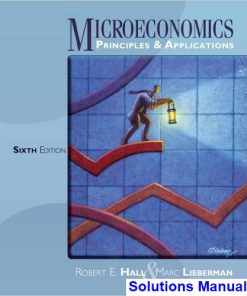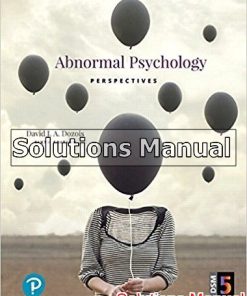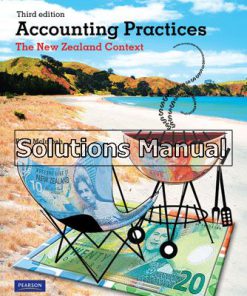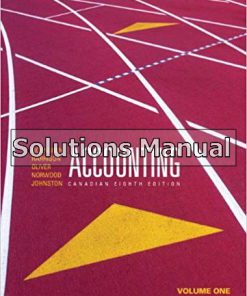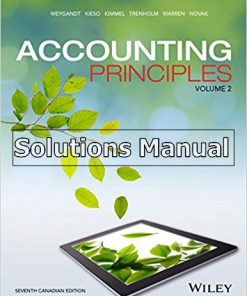Psychology Frontiers and Applications Canadian 6th Edition Passer Solutions Manual
$50.00 Original price was: $50.00.$26.50Current price is: $26.50.
Psychology Frontiers and Applications Canadian 6th Edition Passer Solutions Manual.
Psychology Frontiers and Applications Canadian 6th Edition Passer Solutions Manual
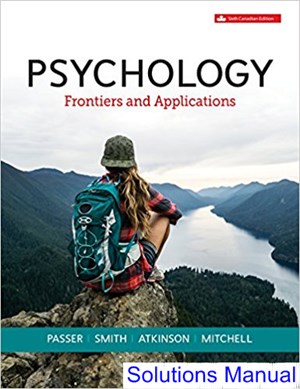
Product details:
- ISBN-10 : 1259369420
- ISBN-13 : 978-1259369421
- Author: Mike Atkinson
Passer’s Psychology: Frontiers and Applications is a very well-known and respected market leading Introductory Psychology resource in Canadian Universities. The Canadian author team – led by Mike Atkinson – is dynamic, student focused, and eager to share their love of Psychology with students.
Psychology: Frontiers and Applications is a thoughtfully integrated book and multimedia package that strikes just the right balance between student friendliness and scientific integrity―a teaching tool that introduces students to psychology as a science, while highlighting its relevance to their lives and society. All of this is done within a conceptual framework that emphasizes relations between biological, psychological, and environmental levels of analysis.
Table contents:
CHAPTER 1 PSYCHOLOGY: THE SCIENCE OF BEHAVIOUR……Page 20
The Nature of Psychology……Page 21
Psychology’s Scientific Approach……Page 23
Thinking Critically about Behaviour……Page 25
Psychology’s Broad Scope: A Simple Framework……Page 27
Psychology’s Intellectual Roots……Page 29
Early Schools: Structuralism and Functionalism……Page 30
The Psychodynamic Perspective: The Forces Within……Page 31
The Behavioural Perspective: The Power of the Environment……Page 32
The Humanistic Perspective: Self-Actualization and Positive Psychology……Page 34
The Cognitive Perspective: The Thinking Human……Page 35
The Sociocultural Perspective: The Embedded Human……Page 37
The Biological Perspective: The Brain, Genes, and Evolution……Page 39
Focus on Neuroscience: The Neuroscience of Imaging Studies……Page 41
Using Levels of Analysis to Integrate The Perspectives……Page 43
Frontiers: Culture, Language, and Behaviour……Page 45
An Example: Understanding Depression……Page 46
Psychology Today……Page 48
Applications: Academic Performance Enhancement Strategies……Page 51
CHAPTER 2 STUDYING BEHAVIOUR SCIENTIFICALLY……Page 55
Scientific Attitudes……Page 56
Research Foundations: Bystander Intervention……Page 57
Gathering Evidence: Steps in the Scientific Process……Page 58
Two Approaches to Understanding Behaviour……Page 59
Defining and Measuring Variables……Page 60
Focus on Neuroscience: The Neuroscience of the Human Brain at Work……Page 64
Descriptive Research: Recording Events……Page 65
Correlational Research: Measuring Associations between Events……Page 69
Experiments: Examining Cause and Effect……Page 72
Confounding of Variables……Page 77
Placebo Effects……Page 78
Experimenter Expectancy Effects……Page 79
Replicating and Generalizing the Findings……Page 80
Frontiers: Does Esp Exist?……Page 81
Ethical Standards in Human Research……Page 82
Ethical Standards in Animal Research……Page 84
Applications: Evaluating Claims in Research and Everyday Life……Page 85
CHAPTER 3 BIOLOGICAL FOUNDATIONS OF BEHAVIOUR……Page 88
Neurons……Page 89
The Electrical Activity of Neurons……Page 90
How Neurons Communicate: Synaptic Transmission……Page 92
Applications: Understanding How Drugs Affect Your Brain……Page 95
The Peripheral Nervous System……Page 98
The Central Nervous System……Page 100
Research Foundations: Wilder Penfield and a Cortical Map……Page 102
The Hierarchical Brain: Structures and Behavioural Functions……Page 106
Frontiers: Mirror Neurons and Autism Spectrum Disorder……Page 116
Focus on Neuroscience: The Neuroscience of Music……Page 122
CHAPTER 5 GENES, EVOLUTION, AND BEHAVIOUR……Page 126
Chromosomes and Genes……Page 127
Focus on Neuroscience: Early Experience, Epigenetics, and Adolescence……Page 130
Behaviour Genetics Techniques……Page 131
Applications: Gene Therapy and Genetic Counselling……Page 132
Heredity, Environment, and Intelligence……Page 137
Biological Reaction Range, the Environment, Personality, and Intelligence……Page 138
Evolution of Adaptive Mechanisms……Page 143
Evolution and Human Nature……Page 145
Evolutionary Psychology……Page 147
Frontiers: Heritability, Evolution, and Politics……Page 148
Research Foundations: Gender Differences in the Ideal Mate……Page 152
How Not to Think about Behaviour Genetics and Evolutionary Psychology……Page 157
CHAPTER 5 SENSATION AND PERCEPTION……Page 160
Sensory Processes……Page 162
Signal Detection Theory……Page 163
Focus on NeuroscienceThe Neuroscience of Subliminal Perception and Prosopagnosia……Page 164
The Difference Threshold……Page 166
Sensory Adaptation……Page 167
Vision……Page 168
Audition……Page 177
Taste and Smell: The Chemical Senses……Page 181
The Skin and Body Senses……Page 183
Frontiers: Sensory Prosthetics: Restoring Lost Function……Page 186
Perception: The Creation of Experience……Page 189
Perception Is Selective: The Role of Attention……Page 190
Perceptions Have Organization and Structure……Page 192
Perception Involves Hypothesis Testing……Page 194
Perception Is Influenced by Expectations: Perceptual Sets……Page 195
Stimuli Are Recognizable under Changing Conditions: Perceptual Constancies……Page 196
Depth and Distance Perception……Page 198
Perception of Movement……Page 199
Illusions: False Perceptual Hypotheses……Page 200
Experience, Critical Periods, and Perceptual Development……Page 203
Research Foundations: Critical Periods: The Role of Early Experience……Page 204
Cross-Cultural Research on Perception……Page 206
Restored Sensory Capacity……Page 207
CHAPTER 6 STATES OF CONSCIOUSNESS……Page 210
The Puzzle of Consciousness……Page 211
Levels of Consciousness: Psychodynamic and Cognitive Perspectives……Page 212
Frontiers: Detecting Awareness……Page 213
The Neural Basis of Consciousness……Page 215
Circadian Rhythms: Our Daily Biological Clocks……Page 216
Keeping Time: Brain and Environment……Page 217
Environmental Disruptions of Circadian Rhythms……Page 219
Stages of Sleep……Page 220
How Much Do We Sleep?……Page 223
Sleep Deprivation……Page 224
Applications: A Good Night’s Sleep……Page 225
Why Do We Sleep?……Page 226
Sleep Disorders……Page 227
The Nature of Dreams……Page 229
Focus on Neuroscience: Dreams and Daydreams……Page 232
Drugs and the Brain……Page 236
Tolerance and Withdrawal……Page 237
Depressants……Page 239
Research Foundations: Drinking and Driving: Decision Making in Altered States……Page 241
Stimulants……Page 242
Opiates……Page 244
Marijuana……Page 245
From Genes to Culture: Determinants of Drug Effects……Page 246
Hypnotic Behaviours and Experiences……Page 249
Theories of Hypnosis……Page 251
Some Final Thoughts……Page 253
CHAPTER 7 LEARNING AND ADAPTATION: THE ROLE OF EXPERIENCE……Page 255
How Do We Learn? The Search for Mechanisms……Page 256
Habituation and Sensitization……Page 257
Classical Conditioning: Associating One Stimulus with Another……Page 258
Basic Principles……Page 259
Applications: of Classical Conditioning……Page 262
Applications: Learning, Virtual Reality, and Therapy……Page 265
Operant Conditioning: Learning through Consequences……Page 266
Skinner’s Analysis of Operant Conditioning……Page 267
Consequences: Determining How to Respond……Page 269
Generalization and Discrimination……Page 273
Schedules of Reinforcement……Page 274
Escape and Avoidance Conditioning……Page 277
Applications: of Operant Conditioning……Page 278
Constraints on Classical Conditioning: Learned Taste Aversions……Page 280
Are We Biologically Prepared to Fear Certain Things?……Page 281
Learning and the Brain……Page 282
Insight and Cognitive Maps……Page 283
Cognition in Classical Conditioning……Page 285
Frontiers: Animal Cognition……Page 287
Cognition in Operant Conditioning……Page 288
Observational Learning: When Others Pave The Way……Page 289
Bandura’s Social-Cognitive Theory……Page 290
Research Foundations: Using Social-Cognitive Learning Theory to Prevent AIDS: A National Experiment……Page 293
CHAPTER 8 MEMORY……Page 295
Memory as Information Processing……Page 296
A Three-Component Model……Page 297
Research Foundations: In Search of the Icon……Page 298
Effortful and Automatic Processing……Page 302
Exposure and Rehearsal……Page 303
Organization and Imagery……Page 304
How Prior Knowledge Shapes Encoding……Page 306
Memory as a Network……Page 308
Types of Long-Term Memory……Page 309
The Value of Multiple and Self-Generated Cues……Page 311
The Value of Distinctiveness……Page 312
Context, State, and Mood Effects on Memory……Page 313
Applications: Improving Memory and Academic Learning……Page 315
The Course of Forgetting……Page 316
Why Do We Forget?……Page 317
Amnesia……Page 319
Forgetting to Do Things: Prospective Memory……Page 321
Frontiers: Methods to Enhance Memory……Page 322
Memory Distortion and Schemas……Page 323
The Misinformation Effect and Eyewitness Testimony……Page 325
The “Recovered Memory” Controversy: Repression or Reconstruction?……Page 326
Sensory and Working Memory……Page 328
Long-Term Memory……Page 329
Focus on Neuroscience: How Are Memories Formed?……Page 330
CHAPTER 9 LANGUAGE AND THINKING……Page 333
Adaptive Functions of Language……Page 334
Properties of Language……Page 335
The Structure of Language……Page 336
Understanding and Producing Language……Page 337
Acquiring a First Language……Page 342
Bilingualism: Learning a Second Language……Page 344
Linguistic Influences on Thinking……Page 347
Focus on Neuroscience: The Bilingual Brain……Page 348
Frontiers: Can Animals Acquire Human Language?……Page 350
Thought, Brain, and Mind……Page 353
Reasoning……Page 354
Problem Solving……Page 357
Knowledge, Expertise, and Wisdom……Page 363
Applications: Guidelines for Creative Problem Solving……Page 364
Mental Imagery……Page 366
Metacognition: Knowing Your Own Cognitive Abilities……Page 369
Research Foundations: “Why Did I Get That Wrong?” Improving Students’ Awareness of Whether They Understand Text Material……Page 370
People also search:
psychology frontiers and applications 6th edition
psychology frontiers and applications
psychology frontiers and applications canadian 6th
psychology frontiers and applications 6th edition download scribd
psychology frontiers and applications 6th edition pdf free
Instant download after Payment is complete
You may also like…
Related products
Solutions Manual
Accounting for Governmental and Nonprofit Entities 15th Edition Wilson Solutions Manual
Solutions Manual
Accounting Texts and Cases 13th Edition Anthony Solutions Manual
Solutions Manual
Accounting Information Systems 12th Edition Romney Solutions Manual
Solutions Manual
Accounting Volume 2 Canadian 8th Edition Horngren Solutions Manual
Solutions Manual
Accounting Volume 1 Canadian 8th Edition Horngren Solutions Manual







